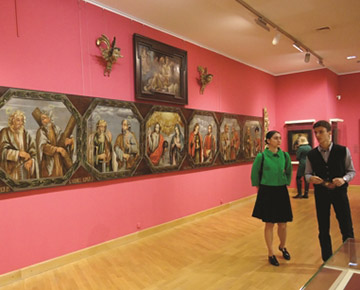
At the Celestial World on the Earth exhibition
The exhibition begins with the Christ Pantocrator and Virgin with Child icons, from the 1670s; these come from St. Nicholas Church in Pinsk and retain the traditional Byzantine iconography. The complex pictorial works of the mid-17th century St. Brigid’s Catholic Monastery in Grodno demonstrates the influence of European and especially Flemish culture on local painters. In 2009, with the blessing of the Metropolitan of Minsk and Slutsk Filaret, the Patriarchal Exarch of All Belarus, the Zhirovichi Monastery sent seven ancient icons from the iconostasis of the Assumption Cathedral (built in approximately 1730) to the National Art Museum. After the museum restorers had removed later updates from these icons, a magnificent, powerful and colourful painting was revealed in the spirit of European baroque. Icons of the Feasts theme present two sets of artwork: from Obrovo (mid-18th century) and Shereshevo (second half of the 18th century). The former are oval shaped with figurative framing and the latter represent rare iconography and unusual composition.

The decorative-and-applied arts are represented by Catholic Church vestments of Western European fabric production and liturgy objects — such as altar and non-altar crosses, chalices for communion and icon frames. These sacred works give an idea about the features and the formation of Belarusian art in a complex interaction with the cultures of both East and West. Belarusian masters learnt new techniques, themes and ideas, while bringing their vision and understanding of the celestial world — closely connected with earthly realities — to church culture.
The Celestial World on the Earth exhibition — featuring church art articles from the 17th-21st century — makes it possible to observe the development of the Belarusian celestial art. This idea was voiced by Culture Minister Boris Svetlov during the solemn opening of the exposition at the National Art Museum. “Owing to the exhibition, we’ve got an opportunity to see the history of development of the Belarusian celestial art which has passed through really trick stages. This was art through which the information on the world, environment and moral values of ordinary people from the past was distributed,” Mr. Svetlov noted. According to him, the power of the show is truly magnificent since it demonstrates the eternal pieces of religious art returned to their life.

Meanwhile, Guido Cornini — the Curator of the Department of Byzantine and Medieval Art of the Vatican Museums — also attended the opening ceremony. He noted that presentation of Belarusian art may pave the way for further research. Mr. Cornini said that the Vatican Museums were greatly inspired by the idea to organise an exhibition of Belarusian art that had never been displayed at the Museums before. “The reasons to implement such a project were manifold. First, Italian people know little about Belarusian art. We thought that the exhibition would be a great opportunity to introduce the audience to something new. Second, geographically, Belarus is located on the border between the East and the West, which is also reflected in the art. Belarusian cultural artefacts present a mixture of different traditions. The third and the most important reason is that the exhibition would be a vivid example of co-operation and peaceful coexistence of different religions in your country. The Vatican Museums welcome all projects that promote peace and cooperation,” the Italian expert explained. He also pointed out that the presentation of Belarusian art may pave the way for further research and, possibly, new discoveries.
To prove the point made by Mr. Cornini, the Belarusian Ministry for Communications and Informatisation presented its own project: a dedication ceremony for a stamp depicting a Russian Orthodox icon and a Catholic icon. Placed together, the icons symbolise the spiritual heritage of the people of Belarus.
By Veniamin Mikheev











